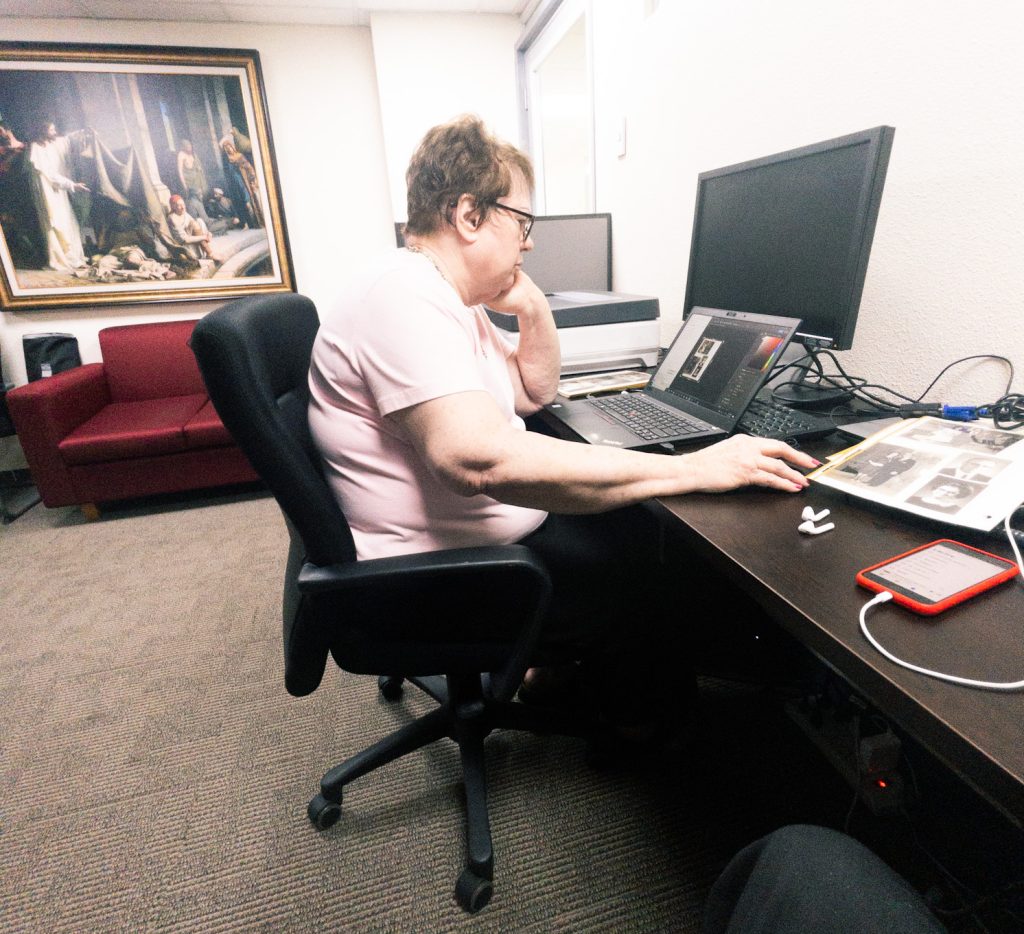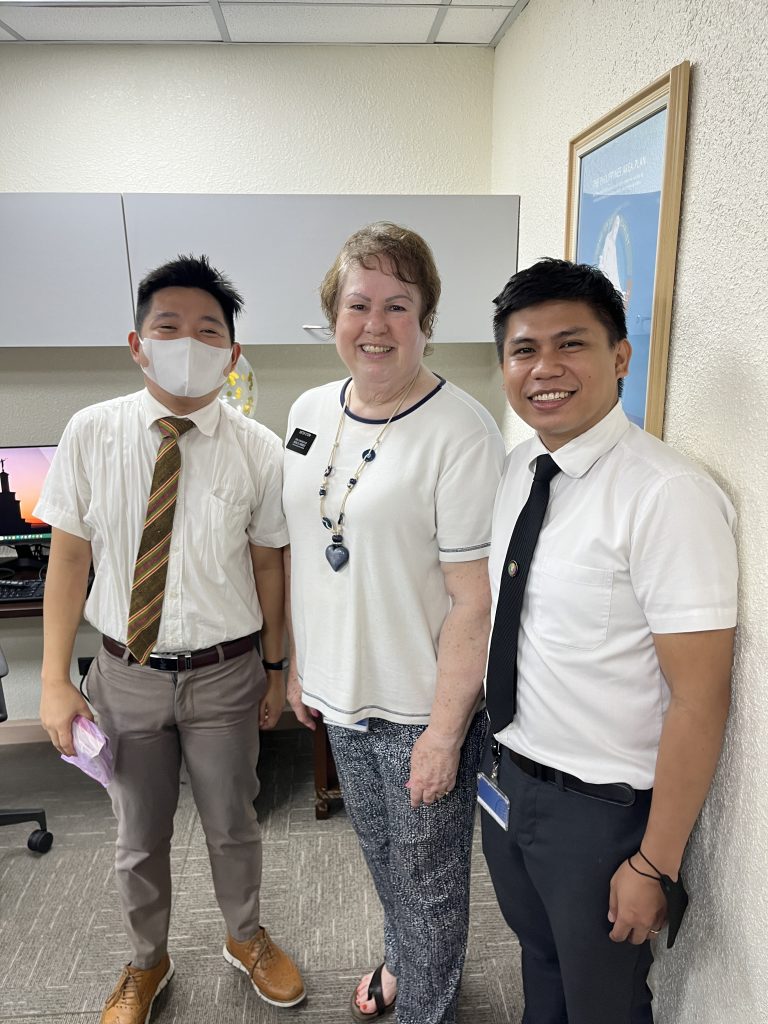Many of you may be aware that it was basically my idea to consider serving a mission. My dear wife initially was less than enthusiastic and wasn’t jumping up and down with excitement about traveling halfway around the world to a hot, humid semi-third world country and leaving her kids and grandchildren behind. However, as she has done many times during our marriage, when an opportunity to serve the Lord comes her way, she has always put the Lord first.
After we were called to the Philippines, one of the saving graces of our mission call is that my wife just loves to work with computers – NOT – and even when she has to do this fairly frequently, my dear wife just puts her head down and soldiers on.
Here is my wife working on a Philippines pioneer saints collection project of scanning and cataloging pictures from a family that lives in Tacloban City which is on one of the islands in the Philippines.

My appreciation for my wife has reached unanticipated heights of respect, love, and gratitude for her willingness to do what she’s asked to do often under less-than-optimal circumstances. She’s a true marvel.
In life and marriage, we all have our ups and downs. For us, as we get older the ups seem to be increasing in frequency and intensity and the downs quickly fade away. Although there have been challenges, my wife now views our mission as an adventure vs. something to be endured. As you would expect, everyone here that gets to know Marcia loves her. Me, they put up with.
Annual History Reports
It’s amazing what you don’t know about the church we attend. I was totally unaware of the commitment the Church has made to collecting and preserving its history. I had been to the Church History Museum in Salt Lake City in the past. I like history and always have. I recall when we took our family on a vacation years ago, we flew to the east coast rented a van and a car and started in New York driving to Palmyra to watch the Hill Cumorah Pageant that our daughter participated in. We drove to all of the church historical sites ending up in Nauvoo before returning home. Our kids were horrified when I would mention the dirty four letter word TOUR that I wanted to take them on. For example, they played video games at the hotel while I took a tour of Gettysburg alone.
We are busy working with 200+ mission, districts, and stakes working with the local unit historians to compile and submit their unit’s annual history which includes a summary of all of the events and activities, This happens in all areas around the world so there is a lot of history being slowly compiled.
Our Hearts Break
One our way home from the Philippines Area Offices to our apartment, we stop at an intersection that is at one of the busiest corners in this part of Quezon City. The red light is about three minutes long to allow the traffic at the intersection to pass. Because of the long red light, a family has staked out this corner as the place to sell a small little group of white flowers to cars waiting for the light to turn green.
I initially thought these little girls that would approach cars at this intersection were begging for money. However, they weren’t begging but selling little bunches of flowers. We’ve been told that in the Philippines children are forbidden by law to beg for money. For this reason, these girls sell flowers which is viewed under the law as a legitimate business activity.
Unable to resist these young girls, we are their regular customers. Over time, we’ve gotten to know these little girls. The girl’s names are Joria (pronounced like Gloria with a J – on the left) and Jasmine. (on the right).

They are at this intersection rain or shine from about 2 pm until at least 9 pm – yes, we have seen them on this corner that late. If they do go to school, it must be in the morning. They’ve told us they are in the 2nd and 3rd grades. I hope this is the case. These young ladies understand some English but I’m not sure how much. They also have a younger brother and another friend that is with them sometimes. Their mother is often out with these young girls with a toddler in tow on her hip.
After we have purchased the flowers and the light changes, as we when drive through the intersection we can see their father (I assume it’s the father) sitting next to a wall at the intersection with what appears to be younger siblings sitting in a shady area while he watches his kids and wife work the street.
A few weeks ago, we were giving a senior missionary sister who works in the area office where we work a ride home. She has been here in the Philippines much longer than we have. After we had stopped at the intersection, Joria and Jasmine approached our car. I rolled down my window and chatted with them briefly as I purchased some more flowers. As the light changed and we pulled away, our passenger told us that her husband had a positive spin on these young girl’s situation and told her that at least these young girls are learning valuable marketing skills and not home playing video games.
Frequently, after seeing and chatting with these young girls and as we drive away, I think of two of our grandkids – Macy and Madilyn which are in the same general age range of Joria and Jasmine but have an entirely different future a head of them.
No Shortage of Poverty
In other parts of the Philippines at intersections, we’ve been approached by mother’s carrying toddlers on their hip that are limp in their mother’s arms in 100+ degree heat begging for money at intersections. This is hard to see.
While I can’t confirm this, in a discussion about these types of this situations a few weeks ago, we were told by some local Filipinos that some of these mothers drug their kids so they don’t fuss so they can be used as props to generate sympathy to get more money.
During my first mission to South Africa, poverty and begging was an issue we faced daily. The heart wrenching moral dilemma then and now is – are you abetting the begging behavior by giving money or if you don’t give some money are you being unchristian? There are no easy answers but here we always roll down the window and buy some flowers.
Speaking of Charitable Giving
One of the interesting benefits we’ve experienced while serving in the Philippines is seeing the scope of the missionary program in the Church. Of course, most of us that are members of the Church may be aware that there are nearly 70,000 18- and 19-year-old young men and women currently serving full-time missions throughout the world (we currently have a grandson and granddaughter in this group) and another nearly 20,000 senior missionary couples like us serving.
What I didn’t really understand prior to be called to serve here is the variety of service that senior couples are involved in during their mission. In a previous blog post, I’ve mentioned some of the types of callings senior couples here in the Philippines are involved with such as dental, medical, local member and leadership support, administrative, and of course Church History (something I didn’t know existed prior to considering a mission) that we were called to do, to name just a few of the types of missions senior coupes serve.
If I had to choose a different type of mission service, I think I would enjoy being involved with the humanitarian efforts of the Church here in the Philippines or in some other area of the world. Prior to arriving here, I was totally unaware of the scope of these humanitarian efforts.
For example, in 2022 more than $1 billion was channeled into 3,692 humanitarian projects in 190 countries and territories plus millions of hours of volunteer service hours. A large portion of the Church’s humanitarian funds are channeled through full-time humanitarian senior couples who work to identify worthwhile projects around the world to fund. There are currently five humanitarian senior couples in the Philippines and this number is set to double in the next year or two.
The other night we had dinner with a humanitarian senior couple. They shared with us the scope of the projects they are involved in funding that range from infant newborn incubators in rural hospitals, computers for schools, rural water projects, agricultural sustainability projects, and English literacy projects…and the list goes on. Wherever there is a justifiable need, the project is likely to be funded. Prior to serving our mission, I wasn’t remotely aware of these types of charitable efforts. Now I see these in real time and the good these humanitarian efforts are doing in the Philippines and around the world, I can say that this inspires me. For the most part, all of this is being done below the radar. At least, for me I was totally unaware of the scope of these humanitarian efforts until seeing it in action here.
What we continue to find of interest in the Philippines:
Before we arrived in the Philippines, I talked to other senior couples that were here or had been here on their first mission and they told us that there were two official languages in the country: English and Tagalog. I assumed that both Tagalog and English were spoken throughout the country. Not so.
A Bit of History
In the 1970s, there was an intense debate on whether the Philippines should have their own national language. While English was evolving into the language of business and the sciences, many felt that to preserve Filipino culture and identity, they argued that a national language was needed. Eventually, the government’s focus shifted on creating a national language called Filipino and de-emphasizing English.
Now that we are here, I was surprised that more people don’t speak English and I wondered why English wasn’t more widely spoken especially since it was an official national language.This is what I’ve learned.
As I mentioned, before coming here I talked to former missionaries that served here in the 1960’s & 1970’s. They told me that they spoke English exclusively and that most people spoke English.
Today, young proselyting missionaries speak the language of where they serve in the Philippines. Since the adoption of Filipino as a national language, although many Filipinos learn English in school, they never become fluent in speaking it because they don’t speak English in the home and only learn it from books.
The more I read and talk to Filipinos, I’m beginning to understand some of challenges that the country faces when it comes to language. Interestingly, there are over 125 different language dialects spoken in the Philippines – who knew. This was totally new information for me. The major languages in the Philippines are Tagalog, English, Cebuano, Ilocano, and the Hiligaynon languages and there are dozens of dialects of each of these languages.
To clarify, Tagalog is a major Filipino language but it is not one of the official languages. The official language is Filipino that has as its foundational component Tagalog but a considerable amount of Spanish, Chinese, and English words have been nativized into the Filipino language. However, for Filipinos Tagalog and Filipino are synonymous and they really don’t make the distinction.
Oh, by the way. I attempted to learn Tagalog and took Tagalog lessons prior to arriving here but concluded it was a hopeless project since we wouldn’t be immersed in the language because we would be speaking mostly English in what we do so I gave up on trying to learn the language because by the time I became minimally conversationally proficient we would be leaving to return home.
By the way, on my first mission in South Africa, the mission at the time was a bilingual – English and Afrikaans. I did learn and became proficient in Afrikaans. However, when I was transferred from an Afrikaans to an English area, I rapidly began to lose my Afrikaans proficiency because I didn’t speak it in an English area. Then when I was transferred back to an Afrikaans area, I had to restart the proficiency learning curve.
Not Tri, or Quad, but Quintuple Lingual.
Recently, a new department opened in the Philippines Area Office. This department is the Leader Member Support (LMS). The purpose of this department is to support church leaders throughout the Philippines by answering questions and support related to membership records, finance, online access, reporting, and other operational and financial issues.


If you take the language challenges and couple this with the fact that in the Philippines many of the local leaders are relatively new and inexperienced. In many cases, these leaders have only been a member of the Church for a few years and are a part of the unpaid army of the lay leadership clergy throughout the world.
Given this dynamic, these leaders need training and support to be able to administer their local congregations that are scattered all over the Philippines. The reason I thought this new department was noteworthy to mention is because of the unique make-up of the eight people that will work in this office. The young men and women that work in LMS are all return missionaries and are multi-lingual ( 3-5 languages) of English, Tagalog, Cebuano, IIanco, and Hiligaynon. In talking to some of these young people, I came away truly impressed of their language aptitude.
Thought of the day: Be like a duck. Calm on the outside but paddling like crazy below the surface.
